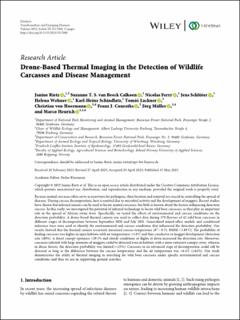| dc.contributor.author | Rietz, Janine | |
| dc.contributor.author | van Beeck Calkoen, Suzanne T. S | |
| dc.contributor.author | Ferry, Nicolas | |
| dc.contributor.author | Schlüter, Jens | |
| dc.contributor.author | Wehner, Helena | |
| dc.contributor.author | Schindlatz, Karl-Heinz | |
| dc.contributor.author | Lackner, Tomáš | |
| dc.contributor.author | von Hoermann, Christian | |
| dc.contributor.author | Conraths, Franz J. | |
| dc.contributor.author | Müller, Jörg | |
| dc.contributor.author | Heurich, Marco Dietmar | |
| dc.date.accessioned | 2024-03-13T12:11:46Z | |
| dc.date.available | 2024-03-13T12:11:46Z | |
| dc.date.created | 2023-12-20T08:40:35Z | |
| dc.date.issued | 2023 | |
| dc.identifier.citation | Transboundary and Emerging Diseases. 2023, 2023 . | en_US |
| dc.identifier.issn | 1865-1674 | |
| dc.identifier.uri | https://hdl.handle.net/11250/3122124 | |
| dc.description.abstract | Because animal carcasses often serve as reservoirs for pathogens, their location and removal are crucial in controlling the spread of diseases. During carcass decomposition, heat is emitted due to microbial activity and the development of maggots. Recent studies have shown that infrared sensors can be used to locate animal carcasses, but little is known about the factors influencing detection success. In this study, we investigated the potential of infrared technology to locate wild boar carcasses, as they play an important role in the spread of African swine fever. Specifically, we tested the effects of environmental and carcass conditions on the detection probability. A drone-based thermal camera was used to collect data during 379 flyovers of 42 wild boar carcasses in different stages of decomposition between September 2020 and July 2021. Generalized mixed-effect models and conditional inference trees were used to identify the environmental and carcass conditions that influenced the detection probability. Our results showed that the thermal camera accurately measured carcass temperature (R2 = 0.75, RMSE = 5.89°C). The probability of finding carcasses was higher in open habitats with air temperatures >3.0°C and thus conducive to maggot development (detection rate ≤80%). A forest canopy openness >29.3% and cloudy conditions or flights at dawn increased the detection rate. Moreover, carcasses infested with large amounts of maggots could be detected even in habitats with a more extensive canopy cover, whereas in dense forests, the detection probability was limited (<25%). Carcasses in an advanced stage of decomposition could still be detected as long as the difference between the carcass temperature and the air temperature was >6.4°C (≤62%). Our study demonstrates the utility of thermal imaging in searching for wild boar carcasses under specific environmental and carcass conditions and thus its use in supporting ground searches. | en_US |
| dc.language.iso | eng | en_US |
| dc.rights | Navngivelse 4.0 Internasjonal | * |
| dc.rights.uri | http://creativecommons.org/licenses/by/4.0/deed.no | * |
| dc.subject | animal carcasses | en_US |
| dc.subject | drone-based thermal camera | en_US |
| dc.subject | thermal imaging | en_US |
| dc.title | Drone-Based Thermal Imaging in the Detection of Wildlife Carcasses and Disease Management | en_US |
| dc.title.alternative | Drone-Based Thermal Imaging in the Detection of Wildlife Carcasses and Disease Management | en_US |
| dc.type | Peer reviewed | en_US |
| dc.type | Journal article | en_US |
| dc.description.version | publishedVersion | en_US |
| dc.rights.holder | Copyright © 2023 Janine Rietz et al. | en_US |
| dc.subject.nsi | VDP::Matematikk og Naturvitenskap: 400::Informasjons- og kommunikasjonsvitenskap: 420::Simulering, visualisering, signalbehandling, bildeanalyse: 429 | en_US |
| dc.source.pagenumber | 12 | en_US |
| dc.source.volume | 2023 | en_US |
| dc.source.journal | Transboundary and Emerging Diseases | en_US |
| dc.identifier.doi | 10.1155/2023/5517000 | |
| dc.identifier.cristin | 2215966 | |
| dc.source.articlenumber | 5517000 | en_US |
| cristin.ispublished | true | |
| cristin.fulltext | original | |
| cristin.qualitycode | 2 | |

